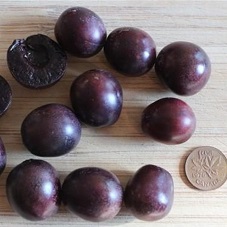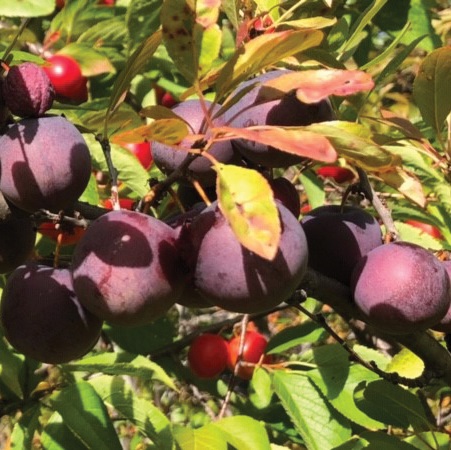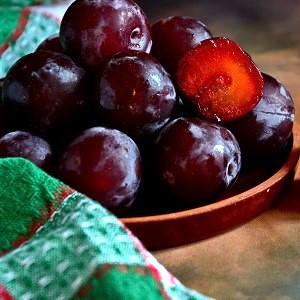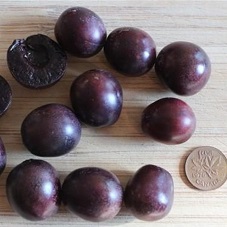Chums
These tough, resilient, shrubby trees derive much of their hardiness from the sandcherry (Prunus pumila var. besseyi) side of the family. Crossing sandcherry with native wild plums (Prunus americana) and in some cases with Japanese plums (Prunus salicina) beefed up the fruit with sweet flesh. The result was a fairly wide range of varieties known as cherry-plums or simply chums. Chums are very disease resistant, drought tolerant and precocious (start bearing at an early age). They make a fine ornamental too, especially in spring with arching branches covered in blossoms. While all chum fruits have astringent skin, we have selected varieties where the least of this trait comes through.
1.25-2m (4-6') bareroot trees
Chum : SAPALTA Semi-Dwarf (Sapalta Seedling)
$56.95
One of the first chum varieties was developed by Professor N.E. Hansen of South Dakota in 1908. He called it 'Sapa'. Later, in 1941, a Sapa seedling was selected near Brooks, Alberta, which had superior fruit size and quality to its parent. Consequently it was named 'Sapalta' – derived from 'Sapa' and 'Alberta'. The reddish purple fruit has very dark red, sweet/tart flesh. Sapalta is one of the best for fresh eating. It makes great jam and is good for canning. Tree form and size is similar to Compass but the fruit is sweeter, more freestone and ripens slightly earlier.
NEEDS A POLLENIZER | ZONE 2/3 | HARVEST: MID-LATE AUG
Rootstocks
G41 Dwarf
(2.5-3.1m/8-10ft)
G935 Small Semi-Dwarf
(3.25-4m/10-13ft)
G969 Small Semi-Dwarf
(3.25-4m/10-14ft)
G30 Semi-Dwarf
(3.6-5m/12-16ft)
G890 Semi-Dwarf
(3.6-5m/13-16ft)
Pollenator definitions
Some trees and many berry plants are SELF-FERTILE ̶means the insect pollinators or even the wind can pollinate the blossoms without the need of a second tree.
NEEDS A POLLENIZER ̶ means another tree of the same type or kind but a different variety must be blooming nearby at the same time.
EXAMPLE A Liberty apple and a Wealthy apple can cross-pollinate. Two trees of the same variety ie: ̶ 2 Wealthy apples, cannot cross pollinate because they are genetically identical.
Other trees are marked as SEMI-FERTILE. These will set fruit without a second tree. However they will often bear more, and sometimes larger fruit if another variety of the same kind of tree is nearby.
You can select 2 different trees of the same kind marked as NEEDS A POLLENIZER or plant one of those along with one SELF-FERTILE or one SEMI-FERTILE. Also consider ripening times ̶ a Goldrush apple might not start blooming before a Pristine is finished.
NEEDS A POLLENIZER ̶ means another tree of the same type or kind but a different variety must be blooming nearby at the same time.
EXAMPLE A Liberty apple and a Wealthy apple can cross-pollinate. Two trees of the same variety ie: ̶ 2 Wealthy apples, cannot cross pollinate because they are genetically identical.
Other trees are marked as SEMI-FERTILE. These will set fruit without a second tree. However they will often bear more, and sometimes larger fruit if another variety of the same kind of tree is nearby.
You can select 2 different trees of the same kind marked as NEEDS A POLLENIZER or plant one of those along with one SELF-FERTILE or one SEMI-FERTILE. Also consider ripening times ̶ a Goldrush apple might not start blooming before a Pristine is finished.






